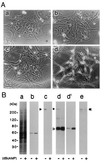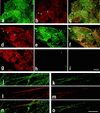Differential expression of dystrophin isoforms and utrophin during dibutyryl-cAMP-induced morphological differentiation of rat brain astrocytes
- PMID: 9600931
- PMCID: PMC27600
- DOI: 10.1073/pnas.95.11.6139
Differential expression of dystrophin isoforms and utrophin during dibutyryl-cAMP-induced morphological differentiation of rat brain astrocytes
Abstract
We have identified isoforms of dystrophin and utrophin, a dystrophin homologue, expressed in astrocytes and examined their expression patterns during dibutyryl-cAMP (dBcAMP)-induced morphological differentiation of astrocytes. Immunoblot and immunocytochemical analyses showed that full-length-type dystrophin (427 kDa), utrophin (395 kDa), and Dp71 (75 kDa), a small-type dystrophin isoform, were coexpressed in cultured nondifferentiated rat brain astrocytes and were found to be located in the cell membrane. During morphological differentiation of the astrocytes induced by 1 mM dBcAMP, the amount of Dp71 markedly increased, whereas that of dystrophin and utrophin decreased. Northern blot analyses revealed that dBcAMP regulates the mRNA levels of Dp71 and dystrophin but not that of utrophin. dBcAMP slightly increased the amount of the beta-dystroglycan responsible for anchoring dystrophin isoforms and utrophin to the cell membrane. Immunocytochemical analyses showed that most utrophin was observed in the cytoplasmic area during astrocyte differentiation, whereas Dp71 was found along the cell membrane of the differentiated astrocytes. These findings suggest that most of the dystrophin/utrophin-dystroglycan complex on cell membrane in cultured astrocytes was replaced by the Dp71-dystroglycan complex during morphological differentiation. The cell biological roles of Dp71 are discussed.
Figures






Similar articles
-
Expression of Dp71 in Müller glial cells: a comparison with utrophin- and dystrophin-associated proteins.Invest Ophthalmol Vis Sci. 2000 Jan;41(1):294-304. Invest Ophthalmol Vis Sci. 2000. PMID: 10634634
-
The role of utrophin and Dp71 for assembly of different dystrophin-associated protein complexes (DPCs) in the choroid plexus and microvasculature of the brain.Neuroscience. 2004;129(2):403-13. doi: 10.1016/j.neuroscience.2004.06.079. Neuroscience. 2004. PMID: 15501597
-
Identification and characterisation of transcript and protein of a new short N-terminal utrophin isoform.J Cell Biochem. 2000 Apr;77(3):418-31. doi: 10.1002/(sici)1097-4644(20000601)77:3<418::aid-jcb7>3.0.co;2-z. J Cell Biochem. 2000. PMID: 10760950
-
Current knowledge of dystrophin and dystrophin-associated proteins in the retina.Histol Histopathol. 2000 Jul;15(3):753-60. doi: 10.14670/HH-15.753. Histol Histopathol. 2000. PMID: 10963120 Review.
-
Utrophin: a potential replacement for dystrophin?Neuromuscul Disord. 1993 Sep-Nov;3(5-6):537-9. doi: 10.1016/0960-8966(93)90111-v. Neuromuscul Disord. 1993. PMID: 8186707 Review.
Cited by
-
Expression of dystrophins and the dystrophin-associated-protein complex by pituicytes in culture.Neurochem Res. 2011 Aug;36(8):1407-16. doi: 10.1007/s11064-011-0466-6. Epub 2011 Apr 12. Neurochem Res. 2011. PMID: 21484268
-
Renal involvement in the pathogenesis of mineral and bone disorder in dystrophin-deficient mdx mouse.J Physiol Sci. 2019 Jul;69(4):661-671. doi: 10.1007/s12576-019-00683-8. Epub 2019 May 11. J Physiol Sci. 2019. PMID: 31079351 Free PMC article.
-
Dystrophin and utrophin isoforms are expressed in glia, but not neurons, of the avian parasympathetic ciliary ganglion.Brain Res. 2008 Jul 7;1218:21-34. doi: 10.1016/j.brainres.2008.04.071. Epub 2008 May 6. Brain Res. 2008. PMID: 18533135 Free PMC article.
-
Dp71 Point Mutations Induce Protein Aggregation, Loss of Nuclear Lamina Integrity and Impaired Braf35 and Ibraf Function in Neuronal Cells.Int J Mol Sci. 2022 Oct 6;23(19):11876. doi: 10.3390/ijms231911876. Int J Mol Sci. 2022. PMID: 36233175 Free PMC article.
-
Alpha1-syntrophin-deficient skeletal muscle exhibits hypertrophy and aberrant formation of neuromuscular junctions during regeneration.J Cell Biol. 2002 Sep 16;158(6):1097-107. doi: 10.1083/jcb.200204076. Epub 2002 Sep 9. J Cell Biol. 2002. PMID: 12221071 Free PMC article.
References
-
- Ozawa E, Yoshida M, Suzuki A, Mizuno Y, Hagiwara Y, Noguchi S. Hum Mol Genet. 1995;4:1711–1716. - PubMed
-
- Sadoulet-Puccio H M, Kunkel L M. Brain Pathol. 1996;6:25–35. - PubMed
-
- Love D R, Hill D F, Dickson G, Spurr N K, Byth B C, Marsden R F, Walsh F S, Edwards Y H, Davies K E. Nature (London) 1989;339:55–58. - PubMed
-
- Blake D J, Love D R, Tinsley J, Morris G E, Turley H, Gatter K, Dickson G, Edwards Y H, Davies K E. Hum Mol Genet. 1992;1:103–109. - PubMed
-
- Tinsley J M, Blake D J, Roche A, Fairbrother U, Riss J, Byth B C, Knight A E, Kendrick-Jones J, Suthers G K, Love D R, Edwards Y H, Davies K E. Nature (London) 1992;360:591–593. - PubMed
Publication types
MeSH terms
Substances
Associated data
- Actions
LinkOut - more resources
Full Text Sources

